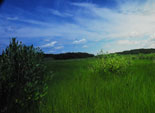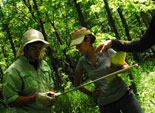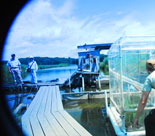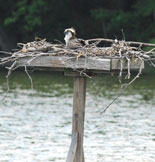 |
 |
 |
Recent Films
Ecosystems on the Edge
A Smithsonian Environmental Research Center/Dancing Star Foundation Co-Production.
Under the guidance of Anson H. Hines, Ph.D, Director of the Smithsonian Environmental Research Center, with production and post-production by the Smithsonian Astrophysical Observatory at the Harvard Smithsonian Center for Astrophysics, these 16 short scientific films encompass new insights regarding the atmosphere, forest canopy, forest floor, farmland, wetlands, shallow-water habitat and deep-water habitat. The film series explores a multitude of fascinating and topical issues being studied by a consortium of international scientists at the 2,650 acre site along Chesapeake Bay that comprise SERC, the Smithsonian Environmental Research Center. Chesapeake is the largest estuary system in the United States and thus provides a fitting scientific laboratory for issues effecting more than 60% of the U.S. population – the 166 million individuals who live along coastlines throughout America, 16 million of whom are directly impacted by Chesapeake.
The 15 films include approximately 110 minutes worth of short documentary form, intimate examinations of "environmental challenges facing ecosystems on the edge of the land and sea, and on the edge of disaster," as SERC scientists write.
The films include 1) an introduction to Chesapeake Bay; 2) terrestrial and aquatic invasive species; 3) atmospheric mercury deposition dealing with the exhaust of coal-fired power plants and the fact that when it rains, microbes in wetlands attach carbon to mercury, thereby enabling mercury to enter the food chain; 4) a look at a photobiological lab at SERC which is measuring the impact of thinning ozone on the ability of phytoplankton to photosynthesize; 5) a look at why trees within the SERC study areas appear to be growing two-to-four times faster than anytime during the last 250 years and what forest response to climate change bodes; 6) a study of forest composition in an era of invasives and what mechanisms are providing preferences and advantages to some species, disadvantages to others in the overall fabric of life and death; 7) the changes being exerted by (non-native) earthworms around Chesapeake and much of the US, and how their turnover rates in the soil are effecting forest carbon dynamics; 8) a study of the small-whorled pogonia, very likely the most endangered orchid in all the United States; 9) a look at watershed and wetland nutrient pollution; 10) a fascinating insight into potential wetlands of the future, based upon SERC's Global Change Research Wetland; 11) a short film on "Why mayflies are like canaries?" particularly with respect to deteriorating stream health; 12) a film exploring the relationship between sunlight and the health of phytoplankton; 13) the life cycle of the female blue crabs who make two crucial journeys in their lives, and what it is that can perilously intrude on the health and predictability of their population dynamics; 14) Loxothylacus panopaei is a parasitic barnacle that literally castrates the tiny mud crabs it infects, hijacking the reproductive systems of Chesapeake's indigenous mud crabs such that they reproduce barnacle larvae instead of their own kind. This is but one of many such predators being tracked and documented in the film; 15) an incisive examination of the death of one of Chesakeape's most vital bivalve members, oysters, who are dying in the increasing proliferation of dead zones, those low oxygen regions caused by pollution from a variety of sources, that can last for millennia.
The series will be distributed to the full Smithsonian and Dancing Star Foundation audiences, as well as promoted through numerous other broadcast and educational outlets.
 BACK TO TOP
BACK TO TOP
 |
|
 |
|
 |
|
 |
|
 |
|
Ecosystems on the Edge
A Smithsonian Environmental Research Center/Dancing Star Foundation Co-Production.
Under the guidance of Anson H. Hines, Ph.D, Director of the Smithsonian Environmental Research Center, with production and post-production by the Smithsonian Astrophysical Observatory at the Harvard Smithsonian Center for Astrophysics, these 16 short scientific films encompass new insights regarding the atmosphere, forest canopy, forest floor, farmland, wetlands, shallow-water habitat and deep-water habitat. The film series explores a multitude of fascinating and topical issues being studied by a consortium of international scientists at the 2,650 acre site along Chesapeake Bay that comprise SERC, the Smithsonian Environmental Research Center. Chesapeake is the largest estuary system in the United States and thus provides a fitting scientific laboratory for issues effecting more than 60% of the U.S. population – the 166 million individuals who live along coastlines throughout America, 16 million of whom are directly impacted by Chesapeake.
The 15 films include approximately 110 minutes worth of short documentary form, intimate examinations of "environmental challenges facing ecosystems on the edge of the land and sea, and on the edge of disaster," as SERC scientists write.
The films include 1) an introduction to Chesapeake Bay; 2) terrestrial and aquatic invasive species; 3) atmospheric mercury deposition dealing with the exhaust of coal-fired power plants and the fact that when it rains, microbes in wetlands attach carbon to mercury, thereby enabling mercury to enter the food chain; 4) a look at a photobiological lab at SERC which is measuring the impact of thinning ozone on the ability of phytoplankton to photosynthesize; 5) a look at why trees within the SERC study areas appear to be growing two-to-four times faster than anytime during the last 250 years and what forest response to climate change bodes; 6) a study of forest composition in an era of invasives and what mechanisms are providing preferences and advantages to some species, disadvantages to others in the overall fabric of life and death; 7) the changes being exerted by (non-native) earthworms around Chesapeake and much of the US, and how their turnover rates in the soil are effecting forest carbon dynamics; 8) a study of the small-whorled pogonia, very likely the most endangered orchid in all the United States; 9) a look at watershed and wetland nutrient pollution; 10) a fascinating insight into potential wetlands of the future, based upon SERC's Global Change Research Wetland; 11) a short film on "Why mayflies are like canaries?" particularly with respect to deteriorating stream health; 12) a film exploring the relationship between sunlight and the health of phytoplankton; 13) the life cycle of the female blue crabs who make two crucial journeys in their lives, and what it is that can perilously intrude on the health and predictability of their population dynamics; 14) Loxothylacus panopaei is a parasitic barnacle that literally castrates the tiny mud crabs it infects, hijacking the reproductive systems of Chesapeake's indigenous mud crabs such that they reproduce barnacle larvae instead of their own kind. This is but one of many such predators being tracked and documented in the film; 15) an incisive examination of the death of one of Chesakeape's most vital bivalve members, oysters, who are dying in the increasing proliferation of dead zones, those low oxygen regions caused by pollution from a variety of sources, that can last for millennia.
The series will be distributed to the full Smithsonian and Dancing Star Foundation audiences, as well as promoted through numerous other broadcast and educational outlets.

